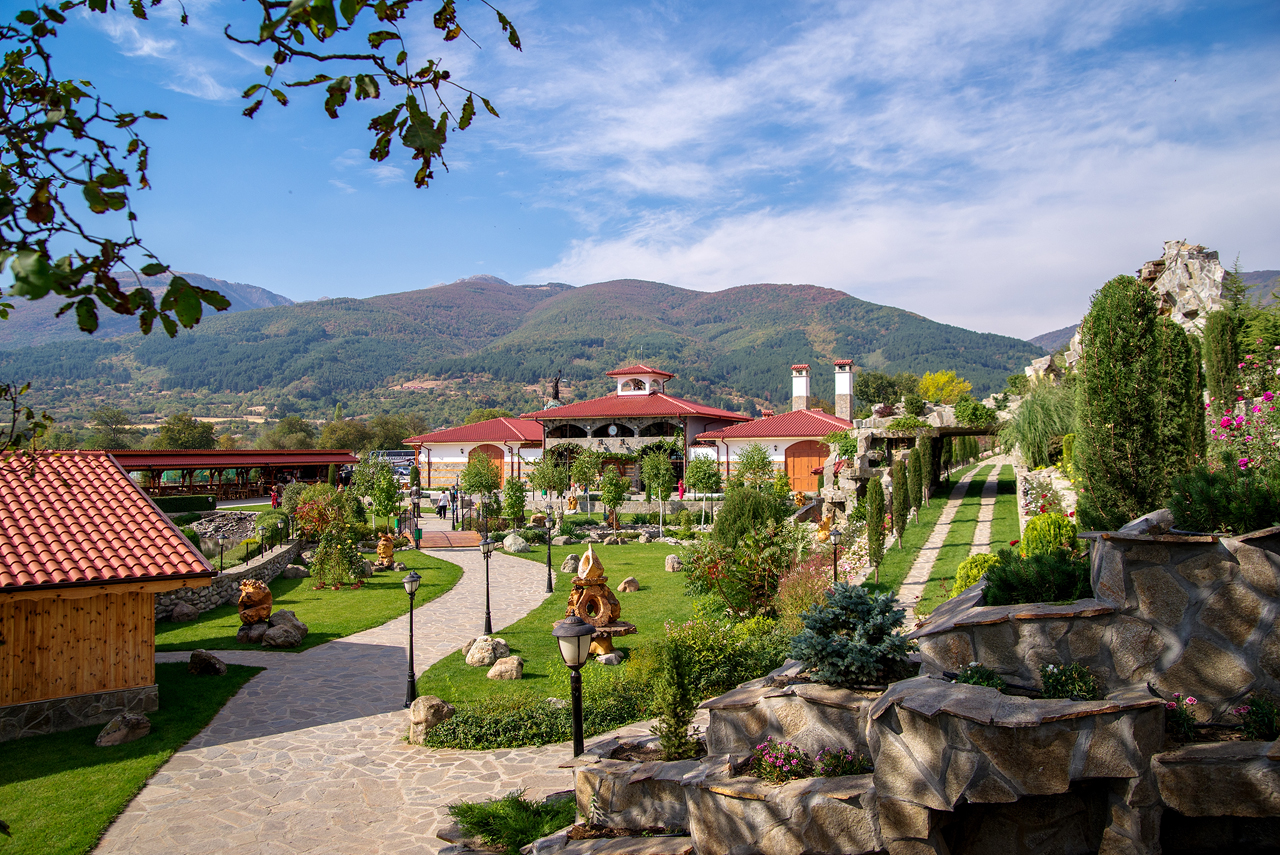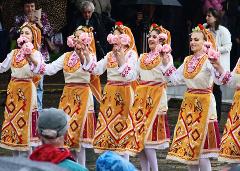Journey Across Bulgaria's Rose Valley

- Duration: 6 Hours (approx.)
- Location: Kazanlak
- Product code: JOURNROSEVAL
About
One of the most beautiful places in Bulgaria is the Rose Valley. Located just to the south of Stara Planina Mountain, this valley is home to gorgeous fields of Rosa damascena – a rose cultivar from which rose oil and perfume are produced. Rose oil and the process of its making are an important part of Bulgarian culture, especially in the regions where these roses grow, and every year its towns and cities celebrate the oil-giving rose and its beauty.
This tour takes you to two of the most significant towns in the Rose Valley, where you’ll get closely acquainted with the Bulgarian Rose and the centuries of tradition associated with it. If you schedule your trip in the couple of days of May / beginning of June, you can join the millions of visitors arriving from all corners of the world to see Kazanlak’s Rose Festival.
Highlights
• Tour the Old Town of Karlovo
• Try your hand at various handcrafts in the museum workshops
• Visit the Damascena Ethnographic Complex
• Taste a wide range of rose-derived food products such as rose brandy and rose jam
• Try the rose essential oils Bulgaria is famous for
• Learn about the process of rose-oil production
• Explore the city of Kazanlak – capital of the Rose Valley
• See the famous Rose Festival and the election of the annual Queen Rose
• Visit historic sites such as the UNESCO protected Kazanlak Tomb
• Enjoy a variety of rose products you can buy as gifts or souvenirs
Description
Day 1
First thing in the morning after breakfast, we’ll head for Karlovo. This picturesque town is one of the most significant settlements in Bulgaria’s Rose Valley, and home to a number of major historical landmarks located in its Old Town.
Every year at the end of May and beginning of June, Karlovo hosts its own version of the Rose Festival that is celebrated all across the valley.
We’ll visit its chief historic house-museums, many of which have workshops and offer rose products.
At the “Buhalov Inn” House you can attend a degustation of coffee, brewed using the “coffee on sand” method, with complementary rose food products, white jam or fig jam. We will see different examples of traditional crafts such as weaving, felting, embroidery, woodcarving.
Pateva House offers a demonstration of the process of drawing essential oils from a miniature distillery filled with various types of seasonal herbs. This is followed by a herbal rakia degustation, authentic Balkan tea, rose and lavender tea. Visitors may get their picture taken wearing a traditional folk costume from this cultural region.
Our next stop is the “Raino Popovitch” House. Here, visitors can craft their own stamped decorative postcards and make cards out of recycled paper. Print yourself unique certificate using an authentic 19th century printing press, complete with a wax stamp! In “The White Yard” House we have the opportunity to see a demonstration of various painting practices in the Zograff style and icon painting techniques. Visitors may even create and paint objects out of clay, and dress up tiny wooden dolls in traditional Bulgarian dresses.
There will be plenty of free time for photos and lunch in one of Karlovo’s traditional Bulgarian restaurants. We can also visit other historic houses in the Old Town.
Day 2
The second day of our tour takes us to the Kazanlak area – a place where the Valley of the Roses and the Valley of the Thracian Kings overlap. Kazanlak is considered the capital of Bulgaria’s Rose Valley.
The Damascena Ethnographic Complex is located a few kilometers away from the town of Kazanlak and is the first stop of our tour for the day.
Damascena gives you the chance to experience the full range of rose products Bulgaria has to offer. You’ll learn about the techniques used to create the Bulgarian rose products, historically and today. You’ll have the chance to taste rose jam, rose honey, rose liquor and rose brandy. You can sample some of the variety of rose-derived essential oils. If you wish to take some of these exquisite products with you as a souvenir or as gifts, you can find all you need at the gift shop. The complex itself is part of that experience – the authentic traditional architecture and gorgeous garden, along with the delicious local cuisine served at its restaurant, make it a joy to visit and a great place to ease you into the world of Bulgarian rose oil.
Our next stop is the city of Kazanlak. We’ll visit its top historic sites, as well as its rose museum.
The Kazanlak Tomb (circa 4th-3rd century BC) is one of the most significant monuments of Thracian culture in the country, included in UNESCO’s list of global cultural inheritance. The remains of a man and a woman were buried inside. This tomb is known for the remarkable wall paintings covering the walls of the corridor and the dome ceiling. The murals depict scenes from the life of the Thracian ruler buried inside the tomb.
From there we’ll delve back into our tour’s main topic – the Bulgarian rose.
The Rose Museum in Rosarium Park, introduces the rich history of Bulgaria’s rose oil production. It contains over 15,000 exhibits pertaining to rose oil. We’ll learn about the history of rose oil production in the country, and about the customs associated with it. Every year, in the beginning of June, Kazanlak hosts a festival dedicated to the Bulgarian rose. This gorgeous spectacle is the most anticipated day of the year for its citizens – and its visitors. It is normally scheduled on the last couple of days of May or the first days of June, but dates vary annually.
What kicks off the Rose festival there is the Queen Rose beauty pageant, where highschool graduates compete for the title of Queen Rose. The winner gets to represent Kazanlak in front of its sister cities all around the world in international forums. The beauty pageant is followed by the “Rose-picking and Rose-boiling” ritual on the Sunday of the holiday – the culmination of the festival. Rose-pickers in folk dresses, folk dancers, kukeri, and performers entertain the crowd and offer rose jam, rose rose liqueur and other rose products. The most nimble-fingered rose-picker is chosen.
This is followed by a performance of the folk rose-picking and boiling ritual. It is all finished off with a carnival.
Over 5000 costumed participants parade down the streets of Kazanlak, dressed like characters from classic literature originating from this region, lead by Queen Rose herself.
After we’ve had our fill of Kazanlak, we’ll travel to the architectural-ethnographic complex of Etara – the first of its kind in the country.
On the way there, we’ll stop by the Shipka Monument – one of the most significant cultural landmarks in Bulgaria. This towering structure commemorates the Battle of Shipka during the Liberation War and those who died in combat. The monument was built in 1930 and resembles a fortress tower and stands atop Mount St. Nicholas.
From there we’ll continue on to the open-air museum.
Etara is a fully functioning reproduction of Bulgarian traditional rural life in the past. It gives travellers and natives alike the chance to get in close touch with Bulgarian culture and folk craftsmanship. There are 16 workshops along the artisan street, where you can see the crafting process and buy handmade souvenirs. The complex features workshops for pottery, woodcarving, icon painting, furriery, cutlery, bakery, sweets shops, musical instruments and many more, all open and active and authentically representing the traditional crafting methods. Special mention goes out to the beautiful examples of Revival Period architecture comprising the village, each house’s façade as colourful and intricately ornamented as the last. Many folk programmes, festivals and events take place in Etara all year round.
Departure and overnight in Plovdiv.


